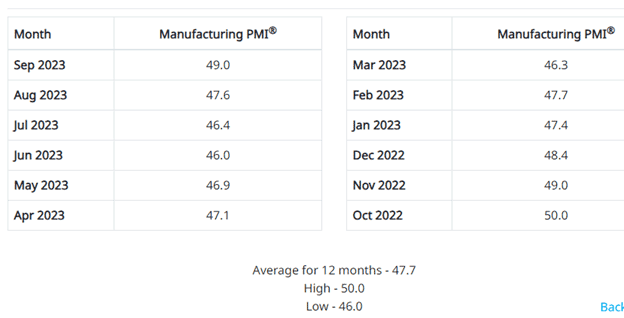The US Purchasing Managers Index (PMI) for September was released this week from the Institute for Supply Management (ISM), and came at a level of 49.0, up 1.4 percentage points versus the 47.6 recorded in August, but also below the key 50 mark that separates US manufacturing expansion from contraction for the 11th straight month.
Before that the US saw a 28-month period of manufacturing growth after May 2020, not long after the start of the pandemic earlier that year.
The PMI tracks closely but not exactly with the overall US economy. The September PMI showed a small overall economic gain after a ninth month of overall economic contraction that in turn came after a 30-month period of expansion.
A Manufacturing PMI above 48.7, over a period of time, generally indicates an expansion of the overall economy.
A similar story with the New Order Index, which rose 2.4 percentage points in September, but was still in contraction territory at 49.2, in a bad sign for future US manufacturing activity.
Other numbers from ISM for the month were mostly down or below the 50 mark.
One exception was the Production Index, up 2.5 percentage points to 52.5, after straddling the line with a score of 50 in August.
The Prices Index was at 43.8, down a big 4.6 percentage points compared to August. That means companies saw a decrease in the cost of components, materials and other inputs, and at a stronger rate last month. This index (below 50 = falling prices) was not that many months ago above 80, as inflation took off.
In more economic bad news, the Backlog of Orders Index registered 42.4, which was 1.7 percentage points lower than the August reading of 44.1, meaning the order book of most companies is shrinking, with the level still well below the 50 mark.
The Supplier Deliveries Index figure of 46.4 was 2.2 percentage points lower than the 48.6 recorded in August. That means supplier lead times are shrinking. Supplier Deliveries is the only ISM index that is inversed; a reading of above 50 indicates slower deliveries, which is typical as the economy improves and customer demand increases – or the reverse.
The Inventories Index increased by 1.8 percentage points to 45.8, indicating inventory levels at companies are decreasing but at a slower rate.
“Companies are still managing outputs appropriately as order softness continues, but the month-over-month PMI improvement in September is a clear positive,” commented Timothy Fiore, Chair of the Institute for Supply Management Manufacturing Business Survey Committee.
(See More Below)
|
CATEGORY SPONSOR: SOFTEON |
|
|
| |
| |
|
|
As always, the ISM report provides a graphic of the full PMI scores the last 12 months, which as can be seen has the measure trending down since October of 2022 and below 50 since November, and it is now averaging just 47.7 over the past year.
US PMI Last 12 Months

Source: ISM
Just five of the 18 industry US sectors tracked by the PMI reported growth in August. Those were: non-metallic mineral products; food, beverage & tobacco products; textile mills; primary metals; and petroleum & coal products.
As always, there were some interesting comments from PMI survey respondents.
A respondent in the chemical sector commented that “We need to coordinate very closely with suppliers in order to yield a more cost-competitive offer. More back and forth is needed to reach a reasonable total price.”
Another from the apparel sector stated that “Markets remain soft. Our customers have about-right inventory levels, but they paid more due to pandemic cost increases. Everyone is holding off on increasing inventories, hoping they can buy at lower costs.”
Finally, a manager in the transportation equipment sector noted that " “Orders and production remain steady, and we are maintaining a healthy backlog. Continued inflation and wage adjustments continue to drive prices up, although we should get some relief from the markets stabilizing.”
Any reaction to this latest PMI data for September? Let us know your thoughts at the Feedback section below.
|